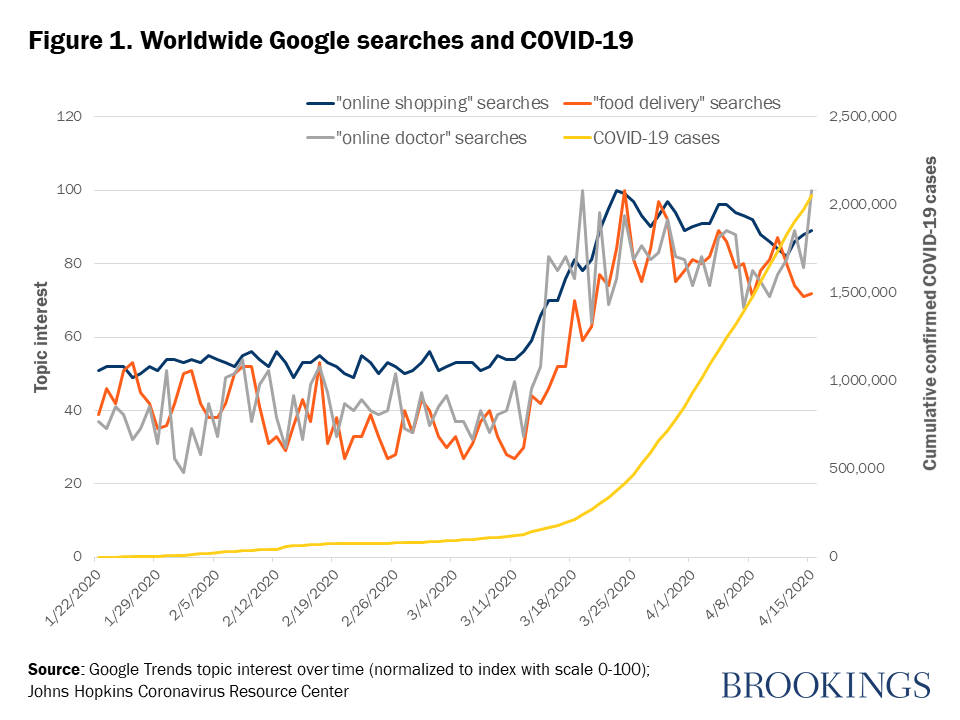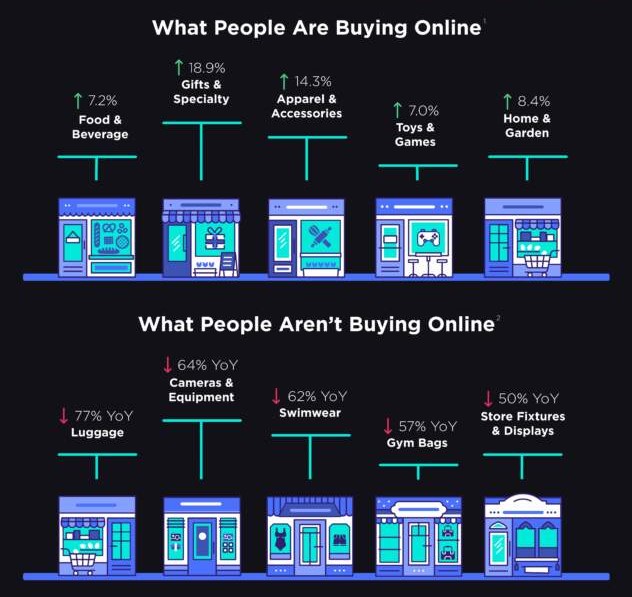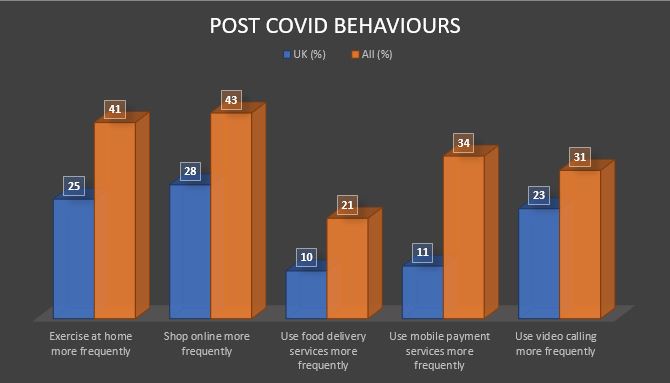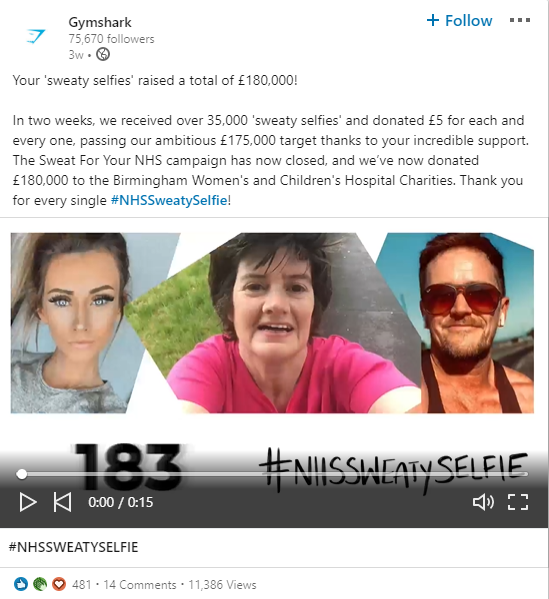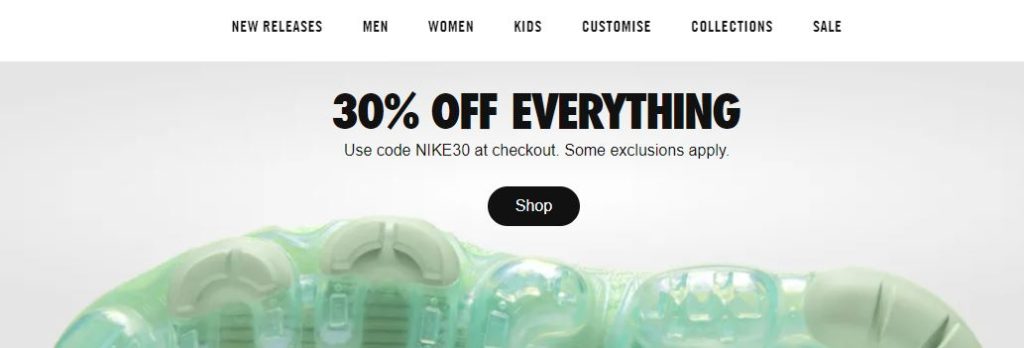Ecommerce Digital Marketing During COVID-19
COVID-19’s Impact on the E-Commerce Sector as a Whole
I think it would be safe to say that almost every person who comes across this blog will have purchased at least one item online that they perhaps would, pre-Covid, not have required, found, or, that they would have traditionally bought in a bricks and mortar location instead.
The majority of non-essential shops and leisure facilities have been forced to close their doors following government guidelines released on March 23rd. This, unsurprisingly, has required brands to adapt to meet their clientele’s ever-evolving requirements, using a variety of approaches.
As people slowly come to terms with what feels like a completely new reality, the E-commerce sector, for the most part, has been experiencing a boom in traffic, engagement, and consequently, an uplift in conversions.
From cost-cutting through the use of discounts, to changes in shipping costs and audience engagement practices, we discuss the ways in which some ecommerce retailers have been, and others could be, growing traffic, boosting conversion rates and maintaining revenue throughout the COVID-19 crisis using ecommerce specific digital marketing.
Points covered include:
- The use of offers, promotions & buy now pay later schemes
- Building customer relations and brand loyalty through social media
- Corporate social responsibility
- The use of conversion rate optimisation (CRO), user experience (UX) reviews & search engine optimisation (SEO)
- Brand transparency
Changes to E-commerce Revenue by Sector During COVID-19
As with all peaks and troughs in the economy, every sector and vertical will be impacted, whether positively or negatively, in one way or another during the course of the pandemic.
Throughout the 2008 Global Financial Crisis, for example, we saw a huge number of redundancies and businesses going bust, however, by the same token, there were other businesses that continued to thrive and prosper, whether naturally, or by adapting their offering and/or approach to business.
The e-commerce sector appears to be one remaining relatively stable at present, despite a bleak economic projection for 2020. Many businesses, in fact, have used ecommerce to preserve jobs throughout the crisis.
This method of sales has begun to emerge as a key pillar in the battle against COVID-19, from shopping online for food and essential goods to minimise unnecessary contact, to online clothes, beauty and health retailers allowing us to look after ourselves throughout the isolation period, from the comfort of our own homes.
(Image Courtesy of Brookings)
Amazon’s sales were up by over 26% throughout the first quarter of 2020 compared with that of 2019, and revenue is set to remain strong as we head into the second half of Q2. This will, however, be offset by the $4 billion investment in PPE and other protective measures being undertaken to support employees.
During April, online fashion stores saw a 21% increase in revenue year-on-year with visits to ecommerce fashion websites up by an average of 9% globally.
According to BigCommerce, sales of food and beverages via online platforms are up by around 7.2%, with online purchases of gifts and speciality items having grown by almost 19%.
When it comes to the fitness sector, there is certainly no shortage of growth, with Peloton’s shares reportedly up by 9.2% as of March, and John Lewis having seen a “significant uplift” in sales of home gym equipment and other fitness-related products since the lockdown began.
(Image Courtesy of BigCommerce)
How has COVID-19 Changed E-commerce & Online Shopping Behaviour?
From just 7% of groceries being bought online to now almost all supermarkets working at maximum capacity in terms of fulfilling online orders, it would be, in our opinion, a mistake to assume that, once this crisis has slowed, we will return to 7%.
Will we, as a nation, have grown so used to trawling the web in search of the best prices, reading reviews at the click of our fingers and ordering our chosen product for next day delivery with the tap of a button, that shops as we knew them become feeble experiences in comparison?
According to Global Web Index’s report; just 14% of British shoppers anticipate that they will return to the shops “immediately” after they open.
Data from the same report suggests that 8% of shoppers in the UK (19% on average across all countries surveyed) are looking for flexible payment options such as paying in instalments.
27% of UK buyers surveyed said they would wait for products to go on sale, this equates to 32% on average across all countries. When we compare this view by gender however, women are 1.2 times more likely to wait for their desired item to go on sale than their male counterparts. Finally, 43% of people agreed that they would shop online more frequently post-Covid.
(Data From Global Web Index)
How E-commerce Stores Have Responded to COVID-19
Offers, Promotions & Discounts
From deals on multi-buys to sitewide sales, almost every online retailer we have come across during this lockdown period has had one offer or another running at some point in time.
The average discounts have been sitting at around 35-40%, with many lucrative enough to get a buyer who may have previously been sitting on the fence, to put their hand in their pocket.
From fashion to health, technology to food, numerous retailers have decided to offer customers free shipping, something that is undoubtedly a contributing factor to sealing the deal for consumers across the globe.
Research has shown that 9/10 consumers say that free shipping is the top incentive to shop online more and that orders with free shipping often result in an order value of around 30% higher than had free shipping not been available.
Below are some examples of how online retailers have been adapting to create a COVID-19 digital strategy through the use of offers, deals and promotions:
- Where possible, businesses have been introducing free shipping.
- Ecommerce stores have been, in many cases, offering a discount, either sitewide or on selected products.
- We have seen numerous examples of companies offering upsells and basket add-ons in the checkout process.
- Extended returns have also been a hot topic in the ecommerce sector, with many extending their return window for users who may not feel comfortable leaving their home to post items.
Customer Engagement & Brand Loyalty Through Social Media
Maintaining customer relationships and growing brand loyalty has never been more important than it is today. Social media teams from some of the world’s largest brands have truly come into their own during this concerning time, exploring new, and modifying existing, approaches to social activity.
The COVID-19 pandemic has proved that consumers simply cannot and will not stop scrolling. The number of UK internet users who have been spending more time than usual on social media during lockdown is a huge 38%.
TikTok the social video app, for example, saw 315 million downloads in the first quarter of 2020, the best recorded quarter for any app, ever.
So, how have brands been utilising their social platforms to curate a “COVID-19 digital strategy” that resonates with their audience?
- By moving into previously unchartered, yet potentially relevant additional social platforms.
- Identifying a suitable tone of voice taking into consideration the current situation and the impact it could be having on their followers/target audience.
- Seizing the opportunity to showcase a proactive, heartfelt, and where relevant/possible, innovative response to the crisis.
- Providing free help and support to users, not posting for the sake of posting, but to make a genuine difference.
- Engaging with followers through competitions, giveaways and sharing user-generated content all helping to build a deeper sense of brand loyalty between themselves and their consumers.
- Changes to slogans and branding geared towards staying home and safe.
(Image Courtesy of We Are Tala Instagram)
Corporate Social Responsibility
Corporate social responsibility (CSR) has been around for a long time, whilst it began as a way for brands to support their local communities and do the right thing, it is also increasingly becoming a way to deepen engagement with modern consumers.
Strong and consistent CSR policies are arguably required more now than ever before, with brands running initiatives to protect employees, pledge in-demand products or services to good causes or raising and donating money to people fighting Coronavirus on the front line.
A fantastic example of this is Gymshark’s “NHS Sweaty Selfie”, designed to get people moving and keeping healthy, whilst also raising money for a great cause (charities supporting services at Birmingham’s Women’s and Children’s Hospitals).
(Image Courtesy of Gymshark Social Media)
Being Approachable and Relatable
With tightly managed photo shoots off the table, brands, especially within the fashion and apparel sector, have been forced to swap studios, photographers and makeup artists for phone cameras, ring lights and self-timers.
Whilst this may not have been within their original plans, it has opened the floor to provide more real, on the go and relatable looks that users appear to be loving, a great COVID-19 digital strategy and solution if you ask us.
(Image Courtesy of ASOS)
Buy Now Pay Later
As 19% of all shoppers have said they now look for flexible payment options, it is no surprise that buy now pay later company Klarna has seen “much higher growth than normal” during this time. Retailer signups are said to have risen more than 20% over the last two months.
Ecommerce Digital Marketing Strategies During COVID-19
Creating and maintaining a strong and efficient COVID-19 digital strategy is exceptionally important for ecommerce brands during this time, below we outline some key recommendations (in addition to the ones highlighted above) to help you maintain momentum.
Be Transparent
Is your dispatch time slower than usual due to operating with a skeleton crew, or your shipping method not quite as quick as normal? If so, then be transparent with your users about this.
Create a COVID-19 banner or FAQ page sharing everything your customers should know about how the virus has impacted you as a business and what they should expect should they decide to make an order.
Being transparent doesn’t only mean addressing changes to dispatch and shipping times, but also updating product pages frequently to let customers know if a product is in high demand or low in stock. As well as keeping in touch with your customer, this will also introduce a sense of urgency and could encourage sales.
Cater to Your Users Needs
These days, the majority of people break their spending into two distinct categories, “essentials” and “non-essentials”. Essentials generally refer to things like food, water, rent and heating whereas non-essentials could include clothes and entertainment.
Due to the government-enforced lockdown, priorities are changing and a whole new category is emerging, the “new essentials”. These, in short, are the things that you need to streamline and adapt to this new way of life and include everything from comfort wear, home improvement tools and office supplies to health and fitness products.
As a part of your COVID-19 digital strategy, if relevant, consider highlighting these new essentials on your site. A great example of this is seen in the adaptations online fashion retailer Pretty Little Thing have made to their menu. Their whole new “Stay at Home” menu option includes everything from “Digi date night” wear to gym wear and virtual hen party accessories because staying home doesn’t have to be boring.
(Image Courtesy of Pretty Little Thing)
Use Click Data to Your Advantage
Whilst we can accept that for some sectors higher than average traffic may not necessarily equate to higher than average sales, you can use this time positively.
Consider installing heatmap tracking software (and upload the relevant privacy policy) and use this traffic to gain valuable insights into user behaviour on your website, this will allow you to gauge any sticking points where user experience could be further improved through conversion rate optimisation activities.
We believe that user data in this form is essential within an ecommerce digital marketing strategy and should be utilised frequently as an un-intrusive way to gauge user satisfaction or frustration when changes are made to a website.
Invest in Quality SEO & Ecommerce Digital Marketing Consultancy
Some businesses will choose to reduce marketing budgets during COVID-19 as a cost-cutting measure, because of this, more stress will be placed on acquiring and converting organic traffic. For this reason, it is an ideal time to ensure that your SEO fundamentals are solid, and you have valuable, optimised content ready at your disposal.
Ensure your site is performing well from a technical and user experience point of view so that all users encounter a seamless experience whatever their chosen device.
Take advantage of any previously untapped areas or resources, whether already available on the site in need of revitalisation, or ideas for creation based on user search volumes and trends.
Visibility is everything when it comes to users who know what they want. If someone is looking for a product specific to a competitor that happens to be unavailable, then your alternatives being as visible as possible could result in users opting for your brand instead.
Highlight Offers and Value Bundles Clearly
If you are in a position to offer customers a discount, value bundle or free shipping, then highlight this deal clearly. Update your homepage to include details of the offer and consider adding a banner or menu addition promoting the same information available as a reminder to users as they browse.
If items are on sale or offered in a value bundle, then be sure to include the original price or normal value as well as the sale/bundle price to highlight their potential saving.You should also look to amplify your offer across social channels and via your email marketing list if suitable.
(Image Courtesy of Nike)
Above we have shared just some of the ways in which you could be supporting your ecommerce website’s growth through the use of digital marketing during this worrying time. The team at Web Results have years of experience in ecommerce digital marketing and strategy across all sectors and are here to support you through this concerning time.
If you would like to book a free consultation then please do not hesitate to get in touch via our online contact form or by calling 01483 429222.


